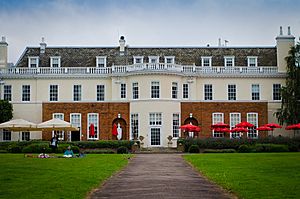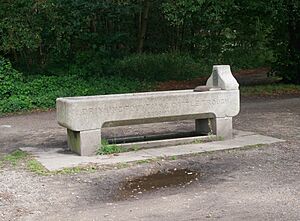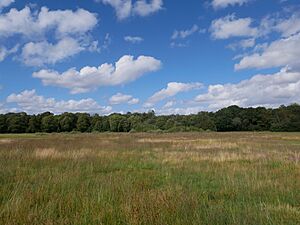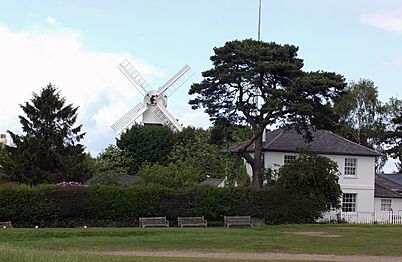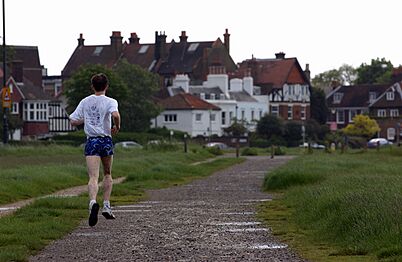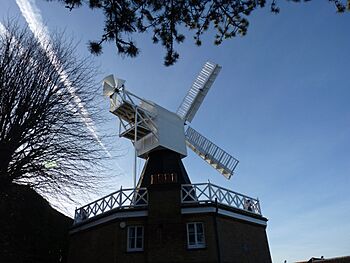Wimbledon Common facts for kids
| Site of Special Scientific Interest | |
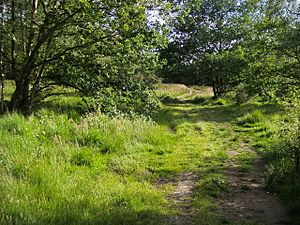 |
|
| Area of Search | Greater London |
|---|---|
| Grid reference | TQ227720 |
| Interest | Biological |
| Area | 346.5 hectares |
| Notification | 1986 |
| Location map | Magic Map |
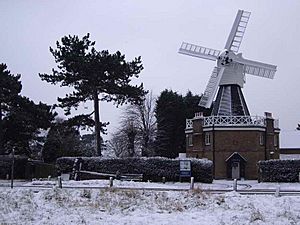
Wimbledon Common is a big open space in Wimbledon, southwest London. It includes three main areas: Wimbledon Common, Putney Heath, and Putney Lower Common. Together, these areas are known as Wimbledon and Putney Commons. They cover a huge 460 hectares (about 1,140 acres) of land. Putney Lower Common is a bit separate, about 1 mile (1.6 km) away from the main common.
Contents
Protecting Wimbledon Commons
Wimbledon Common, Putney Heath, and Putney Lower Common are special places. A law from 1871, called the Wimbledon and Putney Commons Act, protects them. This law means no one can build on them or fence them off. The commons are kept open for everyone to enjoy and for nature to thrive. They are home to many plants and animals.
A Home for Nature
These commons have the largest area of heathland in London. Heathland is a special type of open land with small shrubs. There's also a bog area with rare plants. The western parts have beautiful mixed woodlands. The commons are also a very important home for the amazing stag beetle.
Most of the common is a Site of Special Scientific Interest (SSSI). This means it's a nationally important place for wildlife. It's also a Special Area of Conservation (SAC) under European rules. This makes it even more important for protecting nature.
Who Looks After the Commons?
The commons are managed by a group of eight people called Conservators. Five of them are chosen by local people every three years. The other three are picked by government departments. They make sure the commons stay natural and safe for everyone.
The Conservators have a team of about 23 employees. This team includes Keepers who patrol on horseback to help keep everyone safe. They also have staff who look after the playing fields and do maintenance work. The money to run the commons comes mostly from a yearly fee paid by houses nearby.
A Bit of History
Back in 1864, the owner of the land, Earl Spencer, wanted to build on the common. He tried to pass a law to do this. But people fought against it! In a big win for public land, his plan was stopped. Instead, the Conservators were set up in 1871 to own and protect the common forever.
Famous Spots on the Commons
The Wimbledon Windmill
The windmill is a well-known landmark right in the middle of Wimbledon Common. It's a historic building. Did you know that Robert Baden-Powell wrote parts of his famous book, Scouting for Boys, here in 1908? This book helped start the worldwide Scouting movement!
In the 1800s, the windmill area was used by the National Rifle Association. They held big shooting competitions there every July. Many people, including important guests, came to watch. The event became so popular that the association moved to a bigger site in 1889.
Common Ponds and Streams
You'll find a few shallow pools on Wimbledon Common. Kingsmere and Rushmere are near roads and were likely created when gravel was dug out. Queensmere is a bit deeper and more hidden away. These pools are sometimes called "Pen Ponds."
Beverley Brook is a stream that flows along the western edge of Wimbledon Common. This stream used to mark the old boundary of southwest London. You can even follow a walking path alongside it called the Beverley Brook Walk.
Ancient History at Caesar's Camp
At the southern end of the common, there are remains of an Iron Age hill fort. It's known as Caesar's Camp. People think it was used as a settlement from about 600 to 400 BC. There's even some evidence that the Romans might have attacked it around AD 44.
Exploring Putney Heath
Historical Events and Famous People
Putney Heath has seen many important events. Kings like Charles II and George III reviewed their armies here in the 1600s and 1700s. In 1961, a monument was put up to celebrate the 300th anniversary of the Queen's Royal Surrey Regiment.
An interesting stone tower, called an obelisk, stands on Putney Heath. It was built in 1770 to remember the Great Fire of London. It also celebrated the invention of fireproof plates by David Hartley. He even built a fireproof house nearby and set it on fire to show how well it worked! This obelisk is now a protected historic building.
Many duels (fights between two people with weapons) took place on Putney Heath. In 1798, William Pitt, who was the Prime Minister at the time, had a duel here. Luckily, no one was hurt.
Thomas Cromwell's Birthplace
Thomas Cromwell, a very important statesman who worked for Henry VIII, was born near Putney Heath around 1485. His birthplace was once a famous spot, believed to be where the Green Man pub stands today.
Highwaymen and Legends
For many years, Putney Heath was a popular spot for highwaymen. These were robbers who held up travelers on the roads. In 1795, a famous highwayman named Jeremiah Abershaw was caught here. After he was executed, his body was hung on the heath as a warning. This spot is still known as Jerry's Hill.
Modern Uses of Putney Heath
Because it's quite high up, Putney Heath was used for a shutter telegraph chain from 1796 to 1816. This system sent messages between London and naval ships in Portsmouth using signals. Later, a different semaphore line operated here from 1822 to 1847.
Today, a funfair visits a clearing on Putney Heath every October for a week. It's a popular event for local families.
Sports and Fun on the Commons
The commons are a fantastic place for sports and outdoor activities.
Cricket and Football
Cricket has been played here for a long time. In 1730, a cricket match between Putney and Fulham was played for a prize. The Roehampton Cricket Club has been playing on Putney Heath since 1859.
The famous football club Wimbledon F.C. started as a team of former students who played on the common. Even Fulham F.C. played their home games on Putney Lower Common for a season in the 1880s.
Other Sports
The Richardson Evans Memorial Playing Fields, part of the commons, offer pitches for football and rugby. They host the annual National Schools Sevens rugby tournament. You can also find teams playing Australian Rules Football and Ultimate Frisbee here.
Every Saturday morning, a Parkrun takes place on the common. Hundreds of runners complete a 5-kilometer course that starts and finishes at the Windmill.
The commons are also great for cycling, jogging, and walking. They are home to two golf clubs, The Wimbledon Common Golf Club and London Scottish Golf Club. The very first University Golf Match was played here in 1878. The Thames Hare and Hounds, the oldest cross country running club in the world, is also based here. There are even about 16 miles (26 km) of paths for horse riding!
Protecting the Commons: Legal Matters
Sometimes, there are disagreements about how the commons should be used. In 2012, the Conservators agreed to sell access rights across Putney Common to the local council. This was to allow for a new development. Some local people were unhappy, saying it would change the natural look of the common.
They took their concerns to court, and there have been ongoing discussions about how to balance development with keeping the commons wild and natural. The Charity Commission, which oversees charities, also looked into the matter to make sure everything was done correctly.
The Keepers of the Commons
The Wimbledon and Putney Commons Act of 1871 allows the Conservators to have special officers called Keepers. These Keepers have powers similar to police officers, but only for enforcing the rules of the common. They help make sure everyone follows the bylaws and keeps the common safe.
In the past, Keepers wore bowler hats and tweed jackets. A film from 1959 showed them tackling summer fires and making sure golfers were dressed properly! Today, they continue to play an important role in looking after this special place.
Local Areas Near Wimbledon Common
 |
Putney Vale, Richmond Park | Putney Heath | Southfields |  |
| Kingston Vale, Coombe, Richmond Park | Wimbledon | |||
| Coombe, New Malden | Raynes Park | Wimbledon Chase |
Images for kids
See also
- Wimbledon Manor House
- List of Sites of Special Scientific Interest in Greater London
- The Wombles



